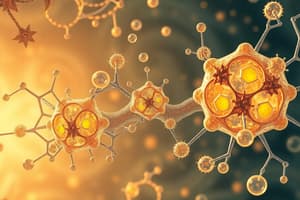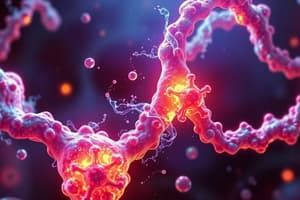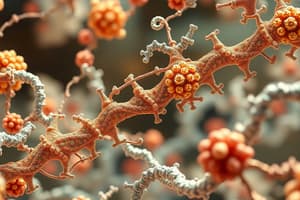Podcast
Questions and Answers
What is the primary role of enzymes in chemical reactions?
What is the primary role of enzymes in chemical reactions?
- To alter the thermodynamics of the reaction
- To change the free energy of the reactants
- To decrease the activation energy (correct)
- To increase the equilibrium constant
What term is used to describe the reactants of enzyme-catalyzed reactions?
What term is used to describe the reactants of enzyme-catalyzed reactions?
- Products
- Inhibitors
- Ligands
- Substrates (correct)
Which of the following interactions can stabilize enzyme-substrate binding?
Which of the following interactions can stabilize enzyme-substrate binding?
- Covalent bonds
- Ionic bonds
- Hydrogen bonds
- All of the above (correct)
What happens to the free energy of the unreacted substrate during an enzyme-catalyzed reaction?
What happens to the free energy of the unreacted substrate during an enzyme-catalyzed reaction?
How do enzymes affect the free energy of the transition state during catalysis?
How do enzymes affect the free energy of the transition state during catalysis?
What effect do enzymes have on the overall energy balance of a biochemical reaction?
What effect do enzymes have on the overall energy balance of a biochemical reaction?
What happens to the entropy of the surrounding water system when a protein binds its ligand?
What happens to the entropy of the surrounding water system when a protein binds its ligand?
Which property primarily differentiates enzymes from other chemical catalysts?
Which property primarily differentiates enzymes from other chemical catalysts?
What role does the transition state play in enzyme binding compared to substrates and products?
What role does the transition state play in enzyme binding compared to substrates and products?
In designing a drug to inhibit an enzyme, which state should the drug resemble for strongest binding?
In designing a drug to inhibit an enzyme, which state should the drug resemble for strongest binding?
Why is it important for the enzyme-substrate and enzyme-product complexes to have similar or higher free energies?
Why is it important for the enzyme-substrate and enzyme-product complexes to have similar or higher free energies?
Which statement accurately describes the binding energy ∆Gbinding regarding the enzyme and its transition state?
Which statement accurately describes the binding energy ∆Gbinding regarding the enzyme and its transition state?
Which of the following statements about enzyme interaction with a drug candidate featuring a negatively charged functional group is true?
Which of the following statements about enzyme interaction with a drug candidate featuring a negatively charged functional group is true?
Which of the following enzyme mutations is likely to result in the weakest interaction with a drug that has a negatively charged group?
Which of the following enzyme mutations is likely to result in the weakest interaction with a drug that has a negatively charged group?
What is the implication of the enzyme having stronger binding energy to the transition state over substrates or products?
What is the implication of the enzyme having stronger binding energy to the transition state over substrates or products?
In the context of enzyme activity, what advantage does binding to the transition state provide?
In the context of enzyme activity, what advantage does binding to the transition state provide?
What does the lock-and-key model suggest about an enzyme's structure when it is not bound to its substrate?
What does the lock-and-key model suggest about an enzyme's structure when it is not bound to its substrate?
Which aspect distinguishes the induced-fit model from the lock-and-key model?
Which aspect distinguishes the induced-fit model from the lock-and-key model?
In the conformational selection model, what happens to the enzyme before it binds to the substrate?
In the conformational selection model, what happens to the enzyme before it binds to the substrate?
What characterizes the predominant conformation of the enzyme in the conformational selection model?
What characterizes the predominant conformation of the enzyme in the conformational selection model?
What initiates the stabilization of the high-affinity conformation in the conformational selection model?
What initiates the stabilization of the high-affinity conformation in the conformational selection model?
Which model suggests that no conformational change is needed for substrate binding?
Which model suggests that no conformational change is needed for substrate binding?
What does the term 'conformational change' refer to in the context of enzyme activity?
What does the term 'conformational change' refer to in the context of enzyme activity?
How does the induced-fit model represent the interaction between enzyme and substrate?
How does the induced-fit model represent the interaction between enzyme and substrate?
What role does the protonated histidine play in the catalytic triad of serine proteases?
What role does the protonated histidine play in the catalytic triad of serine proteases?
How does the environment of an enzyme's active site influence the pKa of amino acid residues?
How does the environment of an enzyme's active site influence the pKa of amino acid residues?
Which amino acid's side chain is critical for enhancing serine's nucleophilicity within the catalytic triad?
Which amino acid's side chain is critical for enhancing serine's nucleophilicity within the catalytic triad?
What is the primary function of the α-amino group of an amino acid in biochemical reactions?
What is the primary function of the α-amino group of an amino acid in biochemical reactions?
Which statement best explains the term 'nucleophilic amino acids'?
Which statement best explains the term 'nucleophilic amino acids'?
In enzyme catalysis, what advantage does a catalytic triad provide?
In enzyme catalysis, what advantage does a catalytic triad provide?
What is the significance of the side-chain ε-amino group of lysine in biochemical processes?
What is the significance of the side-chain ε-amino group of lysine in biochemical processes?
What is the primary reason that many enzymes can catalyze reactions with multiple substrates?
What is the primary reason that many enzymes can catalyze reactions with multiple substrates?
What is formed when an enzyme holds two substrates simultaneously?
What is formed when an enzyme holds two substrates simultaneously?
How do some enzymes bind their substrates in a ternary complex?
How do some enzymes bind their substrates in a ternary complex?
Which mechanism involves an enzyme reacting with one substrate, yielding a modified enzyme before reacting with a second substrate?
Which mechanism involves an enzyme reacting with one substrate, yielding a modified enzyme before reacting with a second substrate?
What do cooperative enzymes have that enable them to display multiple active sites?
What do cooperative enzymes have that enable them to display multiple active sites?
What is true about the action of enzymes following the double displacement mechanism?
What is true about the action of enzymes following the double displacement mechanism?
Which of the following describes multiple active sites on an enzyme?
Which of the following describes multiple active sites on an enzyme?
What characterizes a multisubstrate reaction?
What characterizes a multisubstrate reaction?
What is a notable trait of bifunctional enzymes such as phosphofructokinase-2/fructose-2,6-bisphosphatase?
What is a notable trait of bifunctional enzymes such as phosphofructokinase-2/fructose-2,6-bisphosphatase?
How do enzymes increase the likelihood of chemical reactions occurring?
How do enzymes increase the likelihood of chemical reactions occurring?
What role does the specific shape of an enzyme's active site play in catalyzing reactions?
What role does the specific shape of an enzyme's active site play in catalyzing reactions?
What is the function of the catalytic triad in a serine protease?
What is the function of the catalytic triad in a serine protease?
What happens during covalent catalysis by an enzyme?
What happens during covalent catalysis by an enzyme?
Why are peptide bonds considered less reactive during hydrolysis?
Why are peptide bonds considered less reactive during hydrolysis?
In the hydrolysis of a peptide bond by a serine protease, what role does deprotonated serine play?
In the hydrolysis of a peptide bond by a serine protease, what role does deprotonated serine play?
What is a key outcome of covalent catalysis in enzymatic reactions?
What is a key outcome of covalent catalysis in enzymatic reactions?
How does an enzyme effectively increase the local concentration of reactants?
How does an enzyme effectively increase the local concentration of reactants?
Flashcards
What are substrates?
What are substrates?
Reactants in enzyme-catalyzed reactions.
What is enzyme-substrate interaction?
What is enzyme-substrate interaction?
The interaction between an enzyme and its substrate.
What is activation energy (Ea)?
What is activation energy (Ea)?
The energy required to initiate a chemical reaction.
How do enzymes affect activation energy?
How do enzymes affect activation energy?
Signup and view all the flashcards
What is the transition state?
What is the transition state?
Signup and view all the flashcards
What is ∆Gbinding?
What is ∆Gbinding?
Signup and view all the flashcards
How do enzymes impact the transition state?
How do enzymes impact the transition state?
Signup and view all the flashcards
What is the enthalpy change (∆H) associated with protein-ligand interactions?
What is the enthalpy change (∆H) associated with protein-ligand interactions?
Signup and view all the flashcards
Lock-and-Key Model
Lock-and-Key Model
Signup and view all the flashcards
Induced-Fit Model
Induced-Fit Model
Signup and view all the flashcards
Conformational Selection Model
Conformational Selection Model
Signup and view all the flashcards
Active Site
Active Site
Signup and view all the flashcards
Binding Affinity
Binding Affinity
Signup and view all the flashcards
Activation Energy
Activation Energy
Signup and view all the flashcards
Transition State
Transition State
Signup and view all the flashcards
Binding Energy
Binding Energy
Signup and view all the flashcards
Enzyme's optimal ligand
Enzyme's optimal ligand
Signup and view all the flashcards
∆Gbinding of the transition state
∆Gbinding of the transition state
Signup and view all the flashcards
Designing a drug with highest binding strength
Designing a drug with highest binding strength
Signup and view all the flashcards
Enzyme binding to substrate and product
Enzyme binding to substrate and product
Signup and view all the flashcards
Competitive inhibitor
Competitive inhibitor
Signup and view all the flashcards
Kd (Dissociation constant)
Kd (Dissociation constant)
Signup and view all the flashcards
Ternary complex
Ternary complex
Signup and view all the flashcards
Double displacement (ping-pong) mechanism
Double displacement (ping-pong) mechanism
Signup and view all the flashcards
Substrate binding order
Substrate binding order
Signup and view all the flashcards
Multifunctional enzyme
Multifunctional enzyme
Signup and view all the flashcards
Cooperative enzyme
Cooperative enzyme
Signup and view all the flashcards
Catalytic subsite
Catalytic subsite
Signup and view all the flashcards
Substrate-binding subsite
Substrate-binding subsite
Signup and view all the flashcards
How does the microenvironment affect pKa?
How does the microenvironment affect pKa?
Signup and view all the flashcards
How can a nucleophilic amino acid become more reactive in an enzyme's active site?
How can a nucleophilic amino acid become more reactive in an enzyme's active site?
Signup and view all the flashcards
How does the catalytic triad work?
How does the catalytic triad work?
Signup and view all the flashcards
How does the active site facilitate catalysis?
How does the active site facilitate catalysis?
Signup and view all the flashcards
What is the role of the side-chain amino group of lysine?
What is the role of the side-chain amino group of lysine?
Signup and view all the flashcards
How can the nucleophilicity of lysine be enhanced in the enzyme active site?
How can the nucleophilicity of lysine be enhanced in the enzyme active site?
Signup and view all the flashcards
Why are amino groups important in biochemistry?
Why are amino groups important in biochemistry?
Signup and view all the flashcards
Why is histidine important for enzyme activity?
Why is histidine important for enzyme activity?
Signup and view all the flashcards
Where do enzymes bind to substrates?
Where do enzymes bind to substrates?
Signup and view all the flashcards
How does the active site influence substrate binding?
How does the active site influence substrate binding?
Signup and view all the flashcards
Why do enzymes stabilize the transition state?
Why do enzymes stabilize the transition state?
Signup and view all the flashcards
What is covalent catalysis?
What is covalent catalysis?
Signup and view all the flashcards
What is the catalytic triad?
What is the catalytic triad?
Signup and view all the flashcards
How does covalent catalysis modify the substrate?
How does covalent catalysis modify the substrate?
Signup and view all the flashcards
Study Notes
Catalytic Mechanisms of Enzymes
- Enzymes are catalysts that affect reaction rates without altering thermodynamics or equilibrium.
- Enzymes, being proteins, have unique properties that differentiate them from chemical catalysts.
- Enzymes catalyze reactions by lowering activation energy, increasing reaction rate.
- Enzymes physically interact and bind to reactants (substrates) before catalysis.
Enzyme-Substrate Interactions
- Substrates are ligands that bind to enzymes and undergo chemical changes.
- Ligand binding to proteins is stabilized by various intermolecular interactions depending on functional groups of the ligand and protein residues/backbone.
- Enzyme-substrate binding releases heat and decreases entropy of surrounding water, stabilizing the interaction.
- Enzymes decrease the activation energy (Ea) and stabilize the transition state complex, increasing the reaction rate.
- Diagrams illustrate uncatalyzed vs enzyme-catalyzed reactions, emphasizing decreased activation energy.
Lock-and-Key vs Induced-Fit Models
- Lock-and-key model: Enzymes have a shape that perfectly complements their substrate.
- Induced-fit model: Substrates induce conformational changes in enzymes for optimal binding.
- Conformational selection model: Enzymes exist in multiple conformations, the substrate selecting the high-affinity conformation.
- Different models highlight the mechanisms of substrate recognition and binding. Enzyme-substrate recognition may utilize features of multiple models.
Implications of Molecular Recognition Models
- Specificity: Enzymes exhibit high selectivity for their specific substrates.
- Stereoselectivity: Enzymes often only react with certain stereoisomers of a molecule.
- Induced-fit and conformational selection models explain the ability of enzymes to recognize and bind to multiple related molecules.
Enzyme Active Site
- Enzyme's active site is the region where substrates bind and where catalysis occurs.
- Some enzymes employ mechanisms that change the reactivity of specific enzyme residues.
- Catalytic triad: Example of active site residues, enhancing reactivity through temporary covalent bonds.
Cofactors and Coenzymes
- Enzymes often employ cofactors and coenzymes (non-amino acid components) for catalysis.
- Metal ions: Stabilize substrates or act as catalysts.
- Coenzymes: Organic cofactors (e.g., NAD+, FAD), which may be involved in multiple reactions.
- Coenzymes may be temporary substrates themselves, undergoing changes in the reaction.
Enzyme Function: Multiple Substrates and Active Sites
- Some enzymes may bind and react with multiple substrates simultaneously (ternary complexes).
- Some enzymes react with one substrate at a time (double displacement or ping-pong mechanism).
- Enzymes can have multiple active sites, each catalyzing separate reactions.
Transition States: Enzymes and Reaction Pathways
- Reactions in Enzymes can proceed through different pathways compared to uncatalyzed reactions.
- Enzymes may produce distinct transition states due to the interactions between substrates and specific active sites.
Studying That Suits You
Use AI to generate personalized quizzes and flashcards to suit your learning preferences.
Related Documents
Description
Test your knowledge on the role of enzymes in biochemical reactions. This quiz covers enzyme functions, substrate interactions, and the energetic changes during catalysis. Dive into the intricacies of enzyme-substrate binding and the transition state dynamics.




